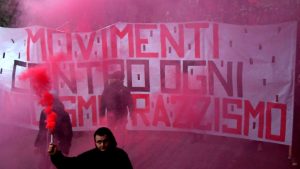By every calculation, Italy’s election in early March will settle nothing. The country may or may not end up with a government straight off after the vote. It could be the populist Five Star Movement or a centre-right coalition composed of the Forza Italia, the Northern League and the Brothers of Italy.
However, having a government is not the same as having governance, a steady hand at the tiller.
For months on end, Italy’s hostility to uninvited foreigners has grown unchecked, with animosity towards visually distinct migrants stoked by unscrupulous politicians. The election campaign itself is turning into a free-for-all with outrageous insults, Islamophobia and racial and ethnic slurs serving as policy prescriptions.
This would be deplorable at any time but it’s particularly mendacious in 2018 when migrant arrivals by boat in Italy have dropped sharply because of a controversial EU-supported deal executed by Italian Interior Minister Marco Minniti with Libya.
The political rhetoric has bloomed, brash and ugly. Last month, a prominent Northern League leader described the 92% ethnically Italian population as an endangered “white race.” Three-time Prime Minister Silvio Berlusconi has said migrants are a “social bomb ready to explode in Italy.”
The charged rhetoric is starting to have a dangerous effect. On February 3, a drive-by shooting spree in the central town of Macerata targeted African immigrants. The person who confessed to carrying out the attack had been a candidate for the Northern League in regional elections last year. Northern League leader Matteo Salvini responded with a perfunctory condemnation of the violence, preferring instead to indulge in fulminations on “unchecked immigration (which) brings chaos, anger… drug dealing, thefts, rapes and violence.”
For all that the diatribes are in Italian, they sound dreadfully familiar. There is a resonance with another, more consequential and equally ugly election campaign elsewhere in the Western hemisphere not too long ago.
As a presidential candidate, Donald Trump promised to harry back to their unquiet homes migrants of every stripe. These included Syrian refugees because they could be the “ultimate Trojan horse” and Mexican “rapists” and “criminals,” whom Trump said were carrying “tremendous infectious disease” (and drugs). As president, Trump has partially managed to execute his proposed “Muslim ban” on entry into the United States.
But what of Italy? How to explain the surge of hateful commentary in a country that should be gladly contemplating a more than 30% drop in migrant arrivals from 2016? It is easy to see the basis for disquiet. More than 600,000 uninvited people have arrived in Italy in the past four years and the numbers only started to fall in 2017.
Should Italian politicians be pushing old news rather than the new, changed, more hopeful reality? Yes and no. It’s easier by far to bash foreigners than to offer viable policies for the eurozone’s third-largest economy.
Here’s a dispiriting point that emerges from the way Italy’s presumptive leaders are behaving. Memories are short, especially when it comes to one’s own hardship. It was not long ago that Italian immigrants to the United States were subject to the same treatment being meted out to African, Muslim and other arrivals to Italy.
A century ago, America was deeply fearful of people they called “dagos” and “wops,” “garlic-eaters” and “spaghetti-benders” from Southern and Eastern Europe. University of Massachusetts history Professor and fourth-generation Italian-American Vincent Cannato said the demonisation was so pronounced that, in 1893, the New York Times was describing Italy as “the land of the vendetta, the mafia and the bandit” and southern Italians as “cutthroats” who sought “to carry on their feuds and bloody quarrels in the United States.”
Three years on from the New York Times’ categorisation, the Boston Globe was asking: “Are Italians a menace? Are they desirable or dangerous additions to our population?”
The resonance is striking, just more than 100 years later.


